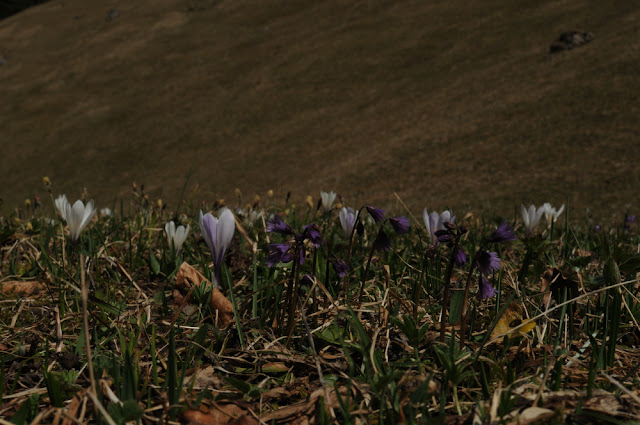April, April, macht was er will is the local saying and the month has certainly lived up to it. Blazing sunshine to begin with, then snow - albeit very temporary - last week. A couple of days of ok weather to start this week, then relentless rain and rather cold temperatures today. Ideal to have a quick nose around the mouth of the Schussen after dropping the girls at kindergarten, particularly as it's the height of migration at present.
The lake shore is rather narrower than over winter as the snow melts off the mountains and fills the lake, so anything feeding on the shore is closer - makes life easier sometimes. The shoreline also has a thriving strandline community, primarily Catabrosa aquatica with lots of Ranunculus scleratus, and a smattering of Cardamine species, Rorippa and tree seedlings. This, and the strandline of decaying leaves of last year, make a good hunting ground for migrant birds, particularly where the shore is backed by woodland.
Sure enough, as I arrive at the lakeside, there is a smart male Whinchat busily diving in and out of the vegetation. A blur of black and white resolves into a male Pied Flycatcher, and the morning feels like it's going to be productive...
By the river mouth the willows are buzzing with Pied Flycatchers and another couple of Whinchat are hopping round the shoreline. A series of shrill 'zeeep's draw attention to a trio of glowing Yellow Wagtails, males a feast of citron, green and powder-blue. More noise from the willows now: a Grasshopper Warbler reeling, a Turtle Dove purring (how long since I last heard that?!), then a Marsh Warbler burbling out a stream of mimicry. A flash of red: a female Common Redstart flirting her tail, and then -almost an afterthought, a pair of Ortolan Buntings hopping quietly around, feeding on seeds of annual ruderals.
After all that, the lake itself is almost a disappointment: just a few hundred swallows skimming the water, a couple of Little Ringed Plover, two Wood Sandpipers and a trio of Greenshank to liven up the standard fare. The rain shows no sign of letting up and my hands are by now somewhat chilly, so heading home seems most sensible, but even that route produces another handful of Pied Flycatchers.
Given the continuing cold and rain, you have to marvel that these birds can make it. Hopefully the forecast improvement in the weekend weather will give them a chance to carry on to wherever they are headed.
Thursday, 27 April 2017
Wednesday, 12 April 2017
I'm not dead...
Honest.
 |
| Red Kite - common and easy to see here, unlike in Devon. My duaghters can now confidently identify them and pick out the Black Kites when they come by. |
 |
| Myosotis rehsteineri. A Lake Constance endemic now, apparently extinct at all its former locations in the Alps.... |
 |
| ...determinedly a non-competitor, this is a plant of the strandline, flowering twice a year when the water levels permit... |
 |
| ...this is the biggest patch of it that I've yet seen. A low-growing, yet startlingly blue and showy plant... |
 |
| ...and although not good at holding out in the face of competing plants, it has a tough little niche to survive in. More on this plant - and others - later. |
 |
| Sympecma paedisca - Siberian Winter Damsel. The more eastern of the winter damselflies in Europe and so far the only individual of the species that I've seen. |
 |
| A spectacular non-native: Giant Knotweed, Fallopia sachalinensis. |
 |
| Crocus meadow in the Brandnertal, Austrian Alps |
 |
| Full of Crocus vernus ssp albiflorus and Soldanella alpina. Carex caryophyllea and an Alchemilla in there too for the connoisseurs |
 |
| Yet another crocus meadow. Bit boring really (not!) |
Subscribe to:
Comments (Atom)